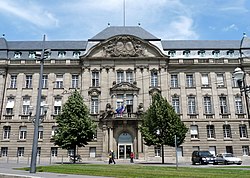
Back Bas-Rhin Afrikaans Département Bas-Rhin ALS Baixo Rin AN الراين الأسفل (إقليم فرنسي) Arabic با-ران ARZ Baxu Rin AST Aşağı Reyn Azerbaijani Bas-Rhin BAN Ніжні Рэйн (дэпартамент) Byelorussian Ніжні Райн (дэпартамэнт) BE-X-OLD
This article needs additional citations for verification. (May 2015) |
Bas-Rhin
's Unterlànd, Unterelsàss, Ingerlànd | |
|---|---|
 Prefecture building of the Bas-Rhin department, in Strasbourg | |
 Location of Bas-Rhin in France | |
| Coordinates: 48°49′N 7°47′E / 48.817°N 7.783°E | |
| Country | France |
| Region | Grand Est |
| Prefecture | Strasbourg |
| Subprefectures | Haguenau Molsheim Saverne Sélestat |
| Government | |
| • Prefect | Josiane Chevalier[1] |
| Area | |
• Total | 4,755 km2 (1,836 sq mi) |
| Population (2022)[2] | |
• Total | 1,156,963 |
| • Rank | 19th |
| • Density | 240/km2 (630/sq mi) |
| Time zone | UTC+1 (CET) |
| • Summer (DST) | UTC+2 (CEST) |
| Department number | 67 |
| Arrondissements | 5 |
| Cantons | 23 |
| Communes | 514 |
| ^1 French Land Register data, which exclude estuaries, and lakes, ponds, and glaciers larger than 1 km2 | |
| Part of a series on |
| Alsace |
|---|
|
|
Bas-Rhin (French pronunciation: [bɑ ʁɛ̃] ⓘ)[3] is a département in Alsace which is a part of the Grand Est super-region of France. The name means 'Lower Rhine', referring to its lower altitude among the two French Rhine departments: it is downstream of the Haut-Rhin (Upper Rhine) department. Both belong to the European Upper Rhine region. It is, with the Haut-Rhin (Upper Rhine), one of the two departments of the traditional Alsace region which until 1871, also included the area now known as the Territoire de Belfort. The more populous and densely populated of the pair, it had 1,152,662 inhabitants in 2021.[4] The prefecture is based in Strasbourg. The INSEE and Post Code is 67.
On 1 January 2021, the departemental councils of Bas-Rhin and Haut-Rhin merged into the European Collectivity of Alsace.
The inhabitants of the department are known as Bas-Rhinois or Bas-Rhinoises.[5]
- ^ Décret du 15 janvier 2020 portant nomination de la préfète de la région Grand Est, préfète de la zone de défense et de sécurité Est, préfète du Bas-Rhin (hors classe), Légifrance
- ^ "Populations de référence 2022" (in French). The National Institute of Statistics and Economic Studies. 19 December 2024.
- ^ traditional German: Niederrhein; Alsatian: Unterelsàss, ‘s Unterlànd or ‘s Ingerlànd; Office pour la Langue et la Culture d’Alsace. "Wàs brücht m'r im Elsàss? Petit lexique français-alsacien" (PDF). oclalsace.org (in French). Archived (PDF) from the original on 2022-10-09. Retrieved 10 December 2013..
- ^ "Populations légales en vigueur à compter du 1er janvier 2024: 67 Bas-Rhin" (PDF). INSEE. Retrieved 16 January 2024.
- ^ "Le nom des habitants des communes de France - Habitants". www.habitants.fr.

